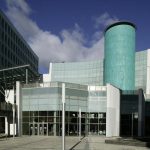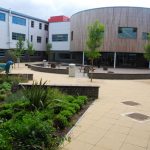Technology Innovation Centre (TIC)
Glasgow
DESCRIPTION:
A nine storey collaborative research and conference centre in the city centre of Glasgow. The building provides research spaces, collaborative meeting spaces and laboratories for around 900 staff. Additionally, the building provides conference facilities and meeting rooms, including a 450 and 150 seat auditorium. Vibration sensitive laboratories are located on the upper levels of the building and also within the double storey basement.
INVOLVEMENT:
Civil and structural design including underground drainage.
The TIC Building is constructed in simple steel framed construction. Lateral stability is provided by 3 No. reinforced concrete cores. The building foundations comprise of large diameter rotary bored piled foundations onto sound bedrock.
At concept design stage a number of different framing options were explored with the design team to determine the optimum framing solution in terms of cost, programme, service strategy, sustainability and adaptability. A steel frame with cellular openings was selected as the most appropriate solution on the basis of the large spans involved and also to satisfy the need that the building must accept alteration and re-configuration with minimal disruption.
CHALLENGES:
Vibration Sensitive Laboratories – The nature of the vibration sensitive equipment called for a vibration performance of VC-A/B for the upper floor laboratories and the more demanding VC-E criteria in some of the basement laboratories. A finite element analysis was carried out on the various floors to ensure there was sufficient mass and stiffness in the floor structure to achieve the required performance criteria.
We also had to work closely with a vibration consultant (NMV) who carried out measurements at the site and provided specialist input on specific isolation measures for various items of plant within the building.
Column free auditorium space – Large double storey lattice transfer girders circa 27m in span were employed above the main auditorium to support the north block and to maintain a column free area below. Careful consideration had to be made in terms of the sequencing of the truss installation during the construction stage.
Double storey basement – The double storey basement construction in poor ground required complex temporary works and dewatering techniques. The contractors’ construction methodology in terms of pour sizes and sequencing was reviewed and amended where necessary in order to comply with best practice recommendation contained within the latest design codes.
BENEFITS TO CLIENT:
The TIC project by the University of Strathclyde (UoS) in Glasgow was highly ambitious and the results are truly transformational. With a project value in the region of £89million it was the single largest project in the Scottish higher education sector at the time, and is unique in that it is not directed at under-graduate teaching, indeed teaching in the traditional sense plays no part in the TIC programme. Instead the TIC bridged the gap between academia and industry and in so doing strengthens collaboration and encourages true innovation in practical research working.







